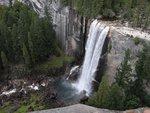Yosemite Rockfall Year in Review: 2013

A rockfall from El Capitan on October 11, 2010
was the largest event of that year.
Photo by Tom Evans.
Following the trend of the previous two years, 2013 was a quiet year for rockfalls in Yosemite. In all, there were 34 documented rockfalls, which is well below the recent (2006-2012) average of about 55 documented rockfalls per year. The cumulative rockfall volume was about 1500 cubic meters (about 4460 tons), also well below average. Given that 35% of rockfalls occurring since 1857 were associated in some way with precipitation (rain or snowmelt), the fact that 2013 was arguably the driest year on record for California may explain the relatively low level of rockfall activity.
The two most consequential rockfalls in Yosemite in 2013 impacted trails. The first occurred early on the morning of May 11 when a block about 320 cubic meters in volume (about 950 tons) fell from the top of the Panorama Cliff and landed on the John Muir Trail below Clark Point. Rock debris covered about 500 meters (1600 feet) of switchbacks, and the trail was closed for several weeks while damaged walls were repaired and the trail cleared.
The second consequential rockfall occurred at about 5 am on the morning of October 5 when a block of about 735 cubic meters (about 2200 tons) fell from Ahwiyah Point north of Half Dome; this was the largest rockfall of 2013. Ahwiyah Point experienced a very large rockfall in 2009 and has had intermittent activity since then. The rockfall on October 5 occurred from the same location as the 2009 event, and also curiously occurred at the same time of day. This early morning timing, combined with the fact that it occurred during the government shutdown, ensured that there were no injuries associated with the rockfall. The Mirror Lake Loop trail, recently reopened after extensive repairs following the 2009 event, experienced some minor damage from boulder impacts. This trail was also closed for several weeks while the source area was monitored and the trail cleared.
Other areas in Yosemite experiencing rockfalls in 2013 include Middle and Higher Cathedral Rocks, the Porcelain Wall west of Half Dome, Glacier Point, Royal Arches, and El Capitan.
It is very likely that there were additional rockfalls in 2013, but these events either were not witnessed or went unreported. If you witness a rockfall of any size, encounter fresh rock debris, or hear cracking or popping sounds emanating from the cliffs, please contact park geologist Greg Stock at 209/379-1420 or by email, or contact park dispatch by dialing 911 within the park. Documented rockfalls are added to the park database (http://pubs.usgs.gov/ds/746/), which enables evaluation of rockfall activity to help improve public safety.
What Should I Do in the Event of a Rockfall?
- Be aware of your surroundings. Rockfall hazard zones occur throughout the park near any cliff faces. If you witness a rockfall from the Valley floor, quickly move away from the cliff toward the center of the Valley. If you are near the base of a cliff or talus slope when a rockfall occurs above, immediately seek shelter behind the largest nearby boulder. After rocks have stopped falling, move quickly away from the cliff toward the center of the Valley. Be aware that rockfalls are inherently unpredictable and may happen at any time. Pay attention to warning signs, stay off of closed trails, and, if unsure, keep away from the cliffs.
- Inform park staff if you witness a rockfall. If you witness or hear a rockfall of any size, please report it by calling 209/379-1420 or reporting it at one of the park Visitor Centers. This information is useful for assessing rockfall hazards and adds to the growing knowledge base of rockfall activity in the park.
- Understand this dynamic natural process. Remember that Yosemite is a wild place. Rockfall is the most powerful geologic agent acting today in Yosemite. The dramatic cliffs of Yosemite are constantly being shaped by this potent natural force.


